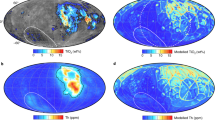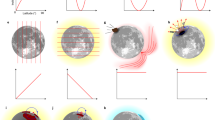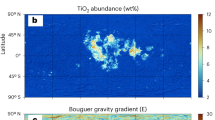Abstract
The compositional asymmetry between the nearside and farside of the Moon and the natural remanent magnetism (NRM) of lunar rocks are poorly understood. The compositional asymmetry is indicated by the 2-km offset towards the Earth of the centre of mass relative to the centre of figure and the concentration of both KREEP and mare basalts on the nearside. Wasson and Warren1 recently noted that these asymmetries may be better explained by an asymmetric crystallization of a primordial magma ocean than by the often proposed2–4 greater thickness of farside anorthositic crust. The NRM5 has been attributed to an ancient lunar dynamo6,7. I propose here a model for the early lunar evolution in which the preferred gravitational energy state consisted of an asymmetric accumulation of a liquid iron alloy (Fe–Ni and a small amount of sulphur) which displaces upwards the cold, primordial, undifferentiated core. The resulting depth asymmetry of the outer partially molten zone leads eventually to the subcrustal accumulation of light, magnesium-rich pyroxenes and olivine, preferentially in one hemisphere, sufficient to explain the offset and also indirectly providing a possible explanation for the nearside concentration of KREEP and mare basalt. Meanwhile, slow downward migration of the iron releases gravitational energy sufficient for convection and dynamo generation in an iron layer for about 109 yr. The proposed present state of the Moon has a symmetrically placed iron core (radius ≃ 500 km), unlike a previous model for the lunar asymmetry8.
This is a preview of subscription content, access via your institution
Access options
Subscribe to this journal
Receive 51 print issues and online access
$199.00 per year
only $3.90 per issue
Buy this article
- Purchase on Springer Link
- Instant access to full article PDF
Prices may be subject to local taxes which are calculated during checkout
Similar content being viewed by others
References
Wasson, J. T. & Warren, P. H. Lunar planet. Sci. 11, Abstr., 1220 (1980).
Wood, J. A. The Moon 8, 73 (1973).
Kaula, W. M. et al. Proc. 5th Lunar Sci. Conf., 3049 (1974).
Haines, E. L. & Metzger, A. E. Proc. Conf. Lunar Highlands Crust (1980).
Fuller, M. Rev. Geophys. Space Phys. 12, 23 (1974).
Runcorn, S. K. et al. Proc. R. Soc. A325, 157 (1971).
Strangway, D. W., Pearce, G. W., Gose, W. A. & Timme, R. W. Earth planet. Sci. Lett. 13, 43 (1971).
Ransford, G. & Sjogren, W. Nature 238, 260 (1972).
Wetherill, G. W. Proc. 8th Lunar Sci. Conf., 1 (1977).
Kaula, W. M. J. geophys. Res. 84, 999 (1979).
Schubert, G., Stevenson, D. J. & Cassen, P. J. geophys. Res. 85, 2531 (1980).
Feigenson, M. D. & Spera, F. J. geophys. Res. Lett. 7, 145 (1980).
Turcotte, D. L. & Oxburgh, E. R. A. Rev. Fluid Mech. 4, 33 (1972).
Brett, R. Geochim. cosmochim. Acta 37, 165 (1973).
Goldstein, B. E., Phillips, R. J. & Russell, C. T. Proc. 7th Lunar Sci. Conf., 3321 (1976).
Vityazev, A. V. & Mayeva, S. V. Izv. Phys. Solid Earth 12, 79 (1976).
Elsasser, W. M. in Earth Science and Meteoritics (eds Geiss, J. & Goldberg, E.) 1 (North-Holland, Amsterdam, 1963).
Stevenson, D. J. Lunar planet. Sci. 11, Abstr., 1088 (1980).
Lambeck, K. & Pullan, S. Phys. Earth planet. Interiors 22, 12 (1980).
Warren, P. H. & Wasson, J. T. Proc. 10th Lunar Sci. Conf., 2051 (1979).
Booker, J. R. J. Fluid Mech. 76, 741 (1976).
Ramberg, H. Phys. Earth planet. Interiors 1, 63 (1968).
Warren, P. H. & Wasson, J. T. Rev. Geophys. Space Phys. 17, 73 (1979).
Shaw, G. H. Phys. Earth planet. Interiors 20, 42 (1979).
Clayton, D. D. in Principles of Stellar Evolution and Nucleosynthesis, 257 (McGraw-Hill, New York).
Stevenson, D. J. Icarus 22, 402 (1974).
Gubbins, D. & Masters, T. G. Adv. Geophys. 21, 1 (1979).
Runcorn, S. K. Science 199, 771 (1978).
Daily, W. D. & Dyal, P. Phys. Earth planet. Int. 20, 255 (1979).
Author information
Authors and Affiliations
Rights and permissions
About this article
Cite this article
Stevenson, D. Lunar asymmetry and palaeomagnetism. Nature 287, 520–521 (1980). https://doi.org/10.1038/287520a0
Received:
Accepted:
Issue Date:
DOI: https://doi.org/10.1038/287520a0
This article is cited by
-
Overview of the Chang’e-4 Mission: Opening the Frontier of Scientific Exploration of the Lunar Far Side
Space Science Reviews (2021)
-
Global Martian surface structure and planetary evolution
Earth, Moon, and Planets (1988)
-
Possible conditions for formation of satellite from protoearth by ejection of material
Earth, Moon, and Planets (1984)
Comments
By submitting a comment you agree to abide by our Terms and Community Guidelines. If you find something abusive or that does not comply with our terms or guidelines please flag it as inappropriate.



